 Technology
Technology  Technology
Technology  Humans
Humans 10 Everyday Human Behaviors That Are Actually Survival Instincts
 Animals
Animals 10 Animals That Humiliated and Harmed Historical Leaders
 History
History 10 Most Influential Protests in Modern History
 Creepy
Creepy 10 More Representations of Death from Myth, Legend, and Folktale
 Technology
Technology 10 Scientific Breakthroughs of 2025 That’ll Change Everything
 Our World
Our World 10 Ways Icelandic Culture Makes Other Countries Look Boring
 Misconceptions
Misconceptions 10 Common Misconceptions About the Victorian Era
 Mysteries
Mysteries 10 Strange Unexplained Mysteries of 2025
 Miscellaneous
Miscellaneous 10 of History’s Most Bell-Ringing Finishing Moves
 Technology
Technology Top 10 Everyday Tech Buzzwords That Hide a Darker Past
 Humans
Humans 10 Everyday Human Behaviors That Are Actually Survival Instincts
 Animals
Animals 10 Animals That Humiliated and Harmed Historical Leaders
Who's Behind Listverse?

Jamie Frater
Head Editor
Jamie founded Listverse due to an insatiable desire to share fascinating, obscure, and bizarre facts. He has been a guest speaker on numerous national radio and television stations and is a five time published author.
More About Us History
History 10 Most Influential Protests in Modern History
 Creepy
Creepy 10 More Representations of Death from Myth, Legend, and Folktale
 Technology
Technology 10 Scientific Breakthroughs of 2025 That’ll Change Everything
 Our World
Our World 10 Ways Icelandic Culture Makes Other Countries Look Boring
 Misconceptions
Misconceptions 10 Common Misconceptions About the Victorian Era
 Mysteries
Mysteries 10 Strange Unexplained Mysteries of 2025
 Miscellaneous
Miscellaneous 10 of History’s Most Bell-Ringing Finishing Moves
10 Fascinating And Forgotten Weapons From History
Over the course of history, people have often wanted each other dead. The annals of the past are full of conflicts between different people, factions, and countries, and as such, advances in weapons technology have long been a vital way for armies to keep a leg up on their rivals.
Along the way, people have come up with very interesting ways to fight one another. Despite their novelty and ingenuity, these weapons have remained relatively obscure. In this list, we’ll explore 10 weapons that deserve that little additional attention—even if they fell into obscurity for a good reason.
10Plumbata
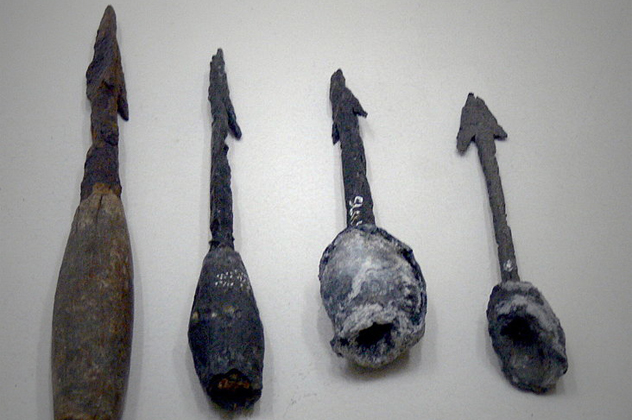
When people think of Roman hand-to-hand weapons, centurion shields, spears, and gladiator equipment usually come to mind. One of the lesser-known weapons the Romans used was called the plumbata, also known as a martiobarbalus.
The plumbata was simple in its design: a spear or dart head on the end of a small weight. Attached to a wooden shaft laced with feathers, it became a small ranged weapon that was effective if thrown either underarm or overarm.
How effective were they? In order to gauge that, all one has to do is take a look within The Military Institutions of the Romans, known in its native language as De Re Militari, a military book written in AD 390.
“The exercise of the loaded javelins, called martiobarbuli, must not be omitted. We formerly had two legions in lllyricum, consisting of six thousand men each, which from their extraordinary dexterity and skill in the use of these weapons were distinguished by the same appellation. They supported for a long time the weight of all the wars and distinguished themselves so remarkably that the Emperors Diocletian and Maximian on their accession honored them with the titles of Jovian and Herculean and preferred them before all the other legions. Every soldier carries five of these javelins in the hollow of his shield. And thus the legionary soldiers seem to supply the place of archers, for they wound both the men and horses of the enemy before they come within reach of the common missile weapons.”
9Trident Main Gauche
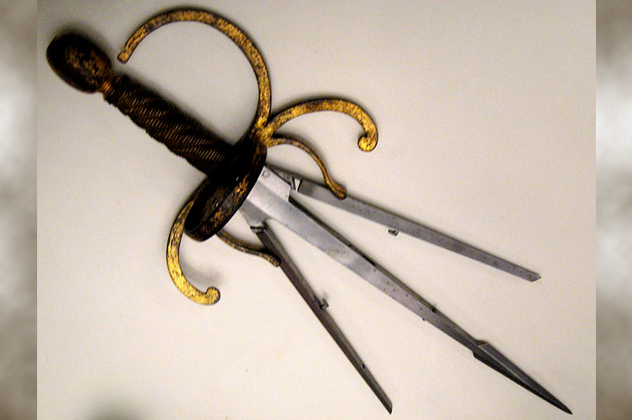
The trident main gauche was a type of dagger called a parrying dagger, which was a small blade held in the left hand to parry sword blows. There were many different types of parrying daggers, but the trident main gauche had one special feature that kicked all the others to the curb: spring-loaded arms.
At the press of a button, this dagger would sprout two arms that came out from either side, giving the dagger a trident-like look. The arms were designed in a way so that the stabbing potential of the dagger was kept, meaning it had enhanced defensive capabilities without completely sacrificing its offensive ones. Should the dagger be needed in the main hand, the arms could be tucked away so that it had its full offensive potential.
8The Man Catcher
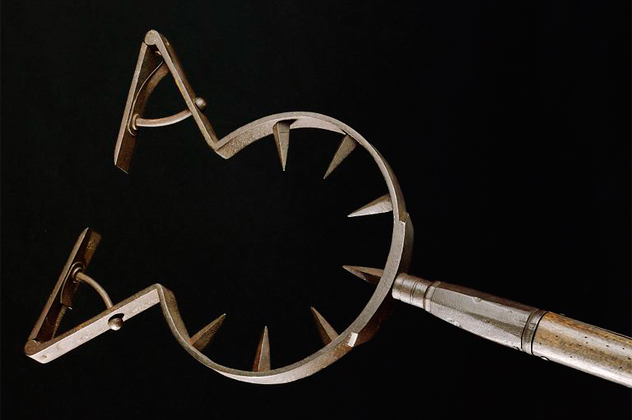
One problem with fighting enemies who are on horseback is that it’s hard to get a solid blow in when your opponent is higher than you. One invention that was used to help even the playing field was the fearsome man catcher.
The man catcher consists of a hoop with spikes around the inside. Man catchers were used to snag riders around the neck and drag them off of their horses, making them easier to kill. The device saw its fair share of use during the wars of the 1500s.
The man catcher also had a secondary use. During war, it was sometimes used to capture important enemies (such as nobles) in a way that kept them alive. It was also useful in times of peace for catching criminals, making it a more terrifying version of modern-day handcuffs. The capturing end of the pole was spring-loaded so that a neck could slip in easily, while the spikes kept the neck from getting out.
7Gauntlet Daggers
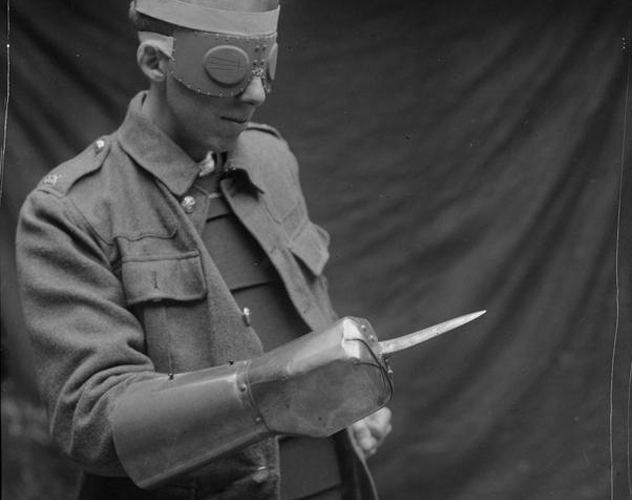
During World War I, soldiers got a nasty taste of trench warfare. Due to the cramped, claustrophobic situations the troops often found themselves fighting in, they sometimes had to resort to a medieval mindset just to stay alive. It was a dirty, bloody conflict, and close-quarters trench weapons had to be simple and ruthlessly efficient if they were to be effective at all.
Some of these simplistic trench weapons were standard military equipment, such as the trench club, a simple wooden weapon meant for melee combat. There are also examples where makeshift weapons were crafted by the soldiers themselves. One such weapon was the gauntlet dagger, a gauntlet made out of crudely arranged light armor with a knife sticking out of the fist. It even came with a bar for you to hold and straps to attach the thing to your forearm. Even though the gauntlet essentially took up a whole hand, it was thought that holding such a weapon would have raised a soldier’s morale, so the pros and cons sort of balanced out.
Unfortunately, there aren’t many records of its origin. A 1920 listing of the item calls it a “spiked gauntlet, German?,” while another record labels it as Anglo-French. Neither of the listings mention any evidence for their claims of country of origin. Regardless, it shows the lengths soldiers would go to in order to maintain peace of mind in the trenches.
6Key Guns
The problem with keeping rowdy prisoners in check is that jailers often have to put themselves into potential danger to perform their duties. During the 17th century, some locksmiths had the ingenious idea of empowering jailers to help keep prisoners in check. Given that it was hard (if not impossible) for a jailer to hold a weapon and unlock a cell door at the same time, the solution was to make the key itself a weapon.
Key guns were just that—keys that contained single-shot pistols within their bodies. Despite their seemingly high novelty value, key guns went through several iterations. Some key guns required the jailer to light the gunpowder with a match in order to set off the gun, but other models came with flintlock mechanisms that were easier to fire in a pinch. The trigger was often around or inside the key’s handle itself, which meant that jailers had to take special care when they opened cell doors.
5Lantern Shields
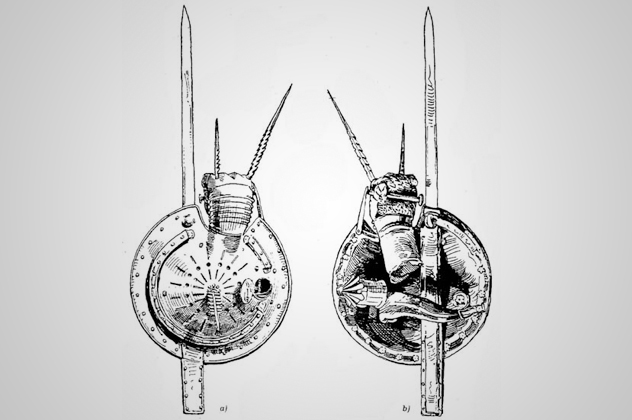
Some of the more inventive experiments in history weren’t necessarily about changing weapons. Sometimes, people put in the effort to modify defensive items so that they could perform a more offensive role. This was the case with the lantern shield, which sports so many features that calling it a “shield” doesn’t do it justice.
The lantern shield’s base was a rounded shield. Attached to the shield was an iron gauntlet, which was worn to equip the shield. On the gauntlet were two serrated blades for snapping an opponent’s blade. If that wasn’t enough, parallel to the gauntlet was a longer blade attached to the shield itself that could be used as an offensive stabbing weapon. Spikes also studded the shield’s surface.
The best feature—and the one that gives this weapon its name—is the secret weapon hidden within it. Behind the shield, the wielder would place a lit lantern. A small leather flap on the front of the shield could be lifted up to reveal the lantern behind it. The idea was that if someone attacked you, you could open the flap. The sudden light from the lantern would “dazzle and confuse” your opponent.
The idea of waving a lantern at someone to dazzle them may seem ineffective and somewhat silly to us, but given how fencers also carried lanterns to blind their opponents, the idea probably stems from some proven techniques at the time.
4Goedendag
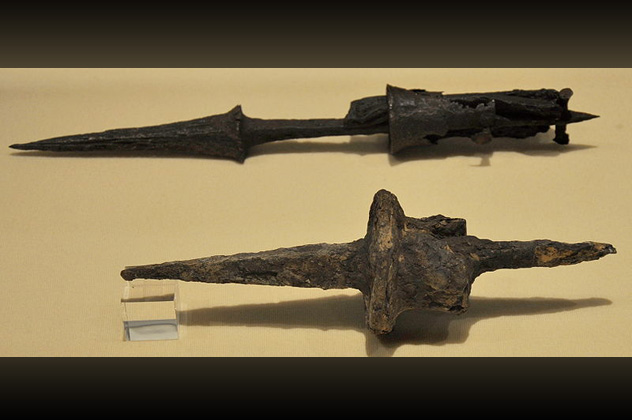
During the 13th century, people were trying to discover interesting ways to tackle armored knights. Heavy weapons such as maces were effective at caving in armor, while bladed weapons were better at harming the person within it. When the Flemish were faced with the problem of French knights, they decided to go with both strategies at once.
The goedendag was a wooden club reinforced with iron rings that had a spike set at the top. Its weight allowed it to be swung like a mace, but the point allowed for piercing attacks as well. Why the name goedendag? Well, there are two theories: The first says that it originated from the Flemish goed dagge, meaning “good dagger.” The second claims that it stems from the Flemish word for “good day,” the story being that those who wielded the weapon would say goedendag to people as they passed by. If the reply came back in French, the passer-by would be bludgeoned on the spot.
As for its effectiveness, it did very well for a brief period. It was cheap, easy to make, and effective to boot. The Battle of the Golden Spurs in 1302 saw 500 French knights falling to the weapon, and rumors spread that one goedendag could take out two mounted knights. It kept its fearful reputation until the Battle of Roosebeke in 1382, when French battle axes and maces outdid the humble stick, pushing the goedendag into an early retirement.
3The Enouy Revolver
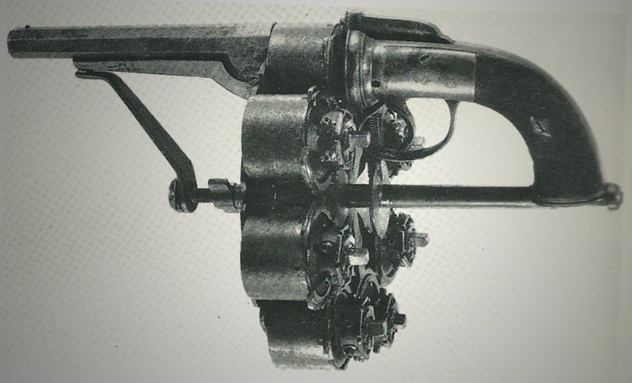
One of the most iconic movie quotes regarding revolvers comes from Dirty Harry, where the titular character asks, “Did I fire six shots or only five?” If Harry had been packing an Enouy revolver, that question would have been a little more ridiculous, because this historical oddity could hold 48 bullets in its cylinders.
The revolver was created by Joseph Enouy in England in 1855. More details of its interesting design can be found in its patent listing:
“Two or more revolving breech-pieces are connected in a frame attached to the stock in such a manner that when the charges in the chambers of one breech-piece have all been fired, the breech-piece may then be removed and others ready charged by successively substituted in its place.”
The end result was something akin to a wheel of revolver chambers, which is exactly how the gun got its nickname, the “Ferris Wheel.” Unfortunately, while its easy-access chambers and its impressive bullet count were revolutionary at the time, its usability left a lot to be desired.
For one, the weight of the chambers made the piece very heavy, and the gun itself was tricky to hold. That made aiming the weapon in the first place a chore. If that wasn’t bad enough, its design meant that there was no way to effectively holster it, meaning you’d have to carry around a very heavy revolver in your hand wherever you went.
As creative as the piece was, it flopped and didn’t see mass production.
2The UP Rocket Launcher
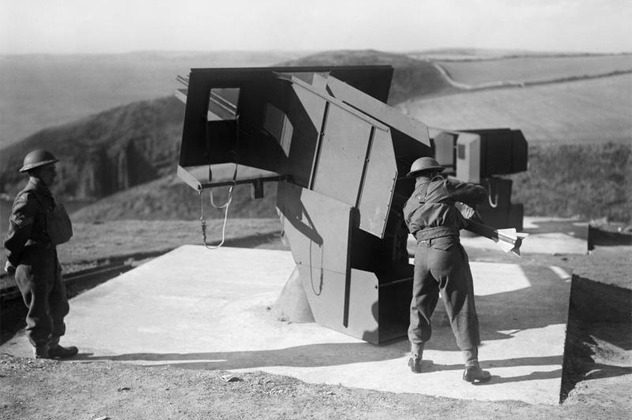
Some of the deadliest weapons used during World War II were mines, which were so feared that special mine-sweeping tanks had to be invented to clear the explosives before they harmed any infantry. One of the ideas that came out of World War II was to take the ground-based terror that minefields gave and put it into the air.
The unrotated projectile (UP) rocket launcher was a large anti-air gun designed to go hand-in-hand with other AA guns. The idea was that the UP rocket launcher would fire a salvo of 10 rockets into the sky. At 300 meters (1,000 ft), the rockets would explode and scatter mines supported by parachutes with cables up to 120 meters (400 ft) in length. Planes would hopefully then fly into the mines, but the abnormally long cables were designed so that a plane could snag the parachute or the wires instead and drag the mine into itself, making it easier for the mines to hit their target.
How did it fare? Not very well. The key element of a mine in the ground was that it was hard to spot. Enemy planes could easily dodge the floating bombs with their conspicuous parachutes. Even worse, should the rockets explode a little too close to the ship, the crew would find themselves under attack by their own weapon as the mines floated back down.
1Wall Guns
When it comes to performance, guns have always had to carry two traits: power and accuracy. The art of a perfect gun comes from a fine balance between these two, packed into a system that can be held and carried by a single soldier. The wall gun, an invention that spanned the 15th–19th centuries, was an example where the demand for power and accuracy was taken to the extreme.
Wall guns weren’t too mechanically different from regular rifles. They loaded bullets the same way and fired the same way. What set them apart was the fact that the minimum barrel length of these guns was an extreme 1.5 meters (5 ft).
The incredible length had a purpose. Such a long barrel meant that the bullet would come out faster and with more accuracy than it would from a regular rifle. While this gun’s counterparts had trouble shooting someone at a distance of 30 meters (100 ft), wall guns could take out a target at 180 meters (600 ft), making them early versions of sniper rifles. Their length did mean that they had to be fired off a tripod or a wall, which is how they got their name. Carrying a wall gun from one point to another took several soldiers, sometimes even a cart.
Who used them? The idea was kicked about in Asia during the 15th century, but the British ran with it during the 17th century and began producing these guns for naval fleets. The Chinese had their own variant used from the 1700s up until World War II, which was nicknamed the “Jingal” by the British. It was eventually outshone by advancements in technology, but its near-comical length makes it a much sought-after piece for gun collectors around the world today.
S.E. Batt is a freelance writer and author. He enjoys a good keyboard, cats, and tea, even though the three of them never blend well together. You can follow his antics on Twitter over at @Simon_Batt or on his fiction website, sebatt.com/.








